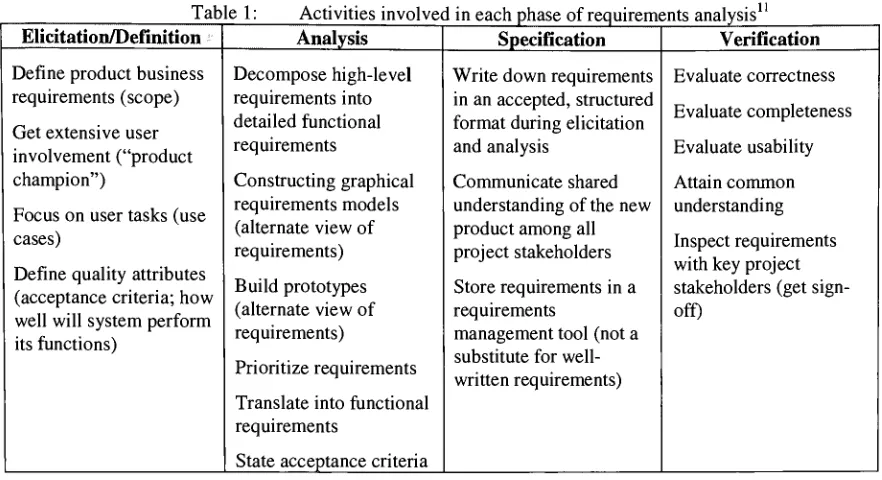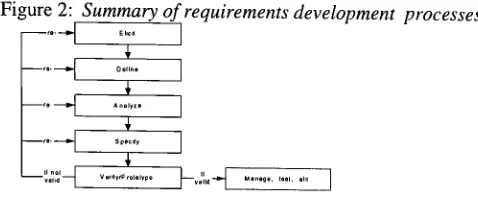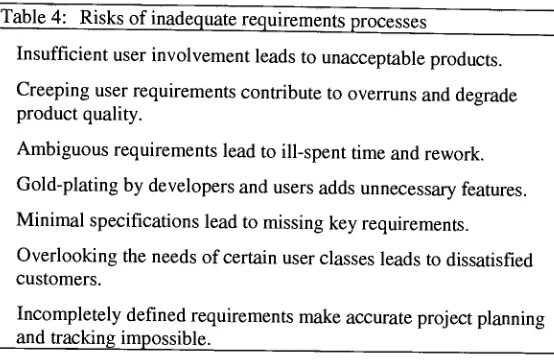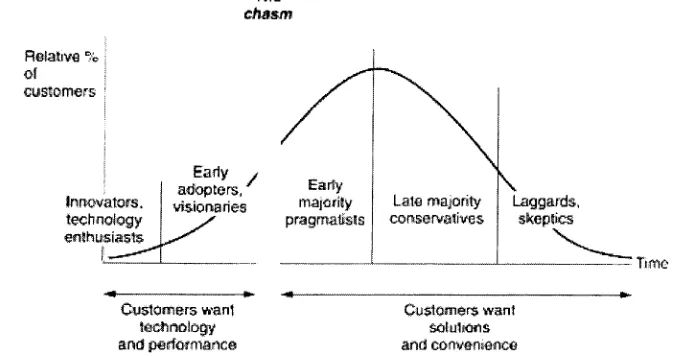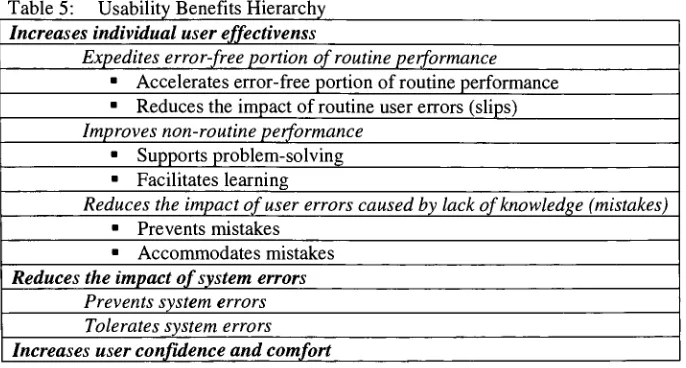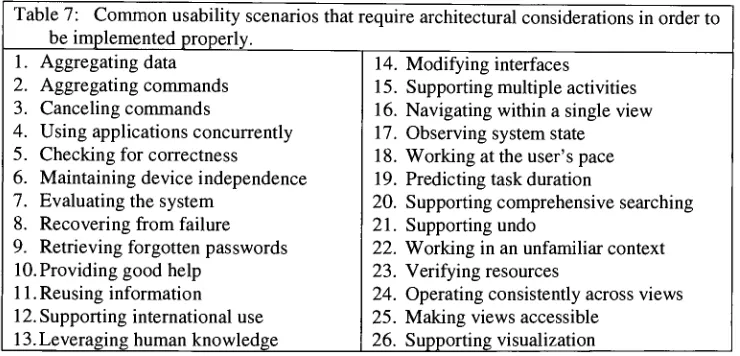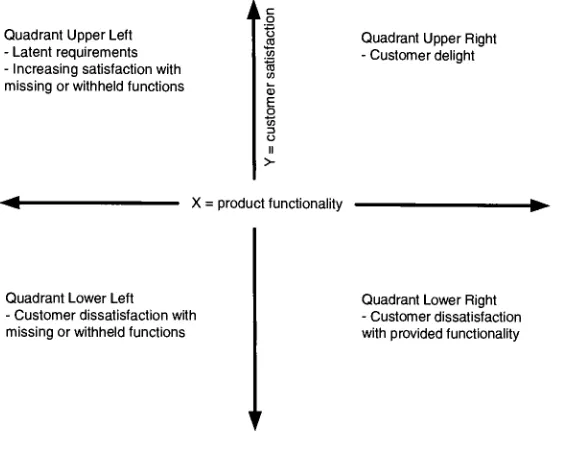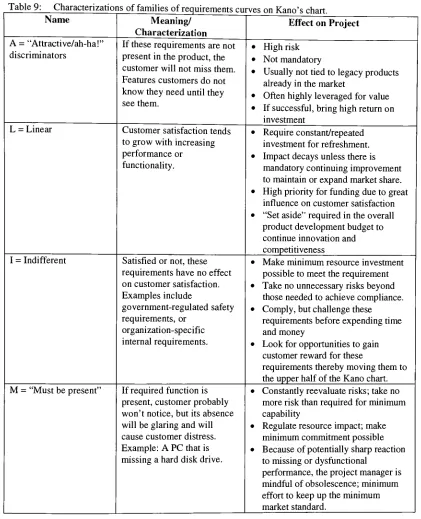Rochester Institute of Technology
RIT Scholar Works
Theses
Thesis/Dissertation Collections
2001
The Effect of software requirements analysis on
project success and product quality
Vera Berenbaum
Follow this and additional works at:
http://scholarworks.rit.edu/theses
This Thesis is brought to you for free and open access by the Thesis/Dissertation Collections at RIT Scholar Works. It has been accepted for inclusion
in Theses by an authorized administrator of RIT Scholar Works. For more information, please contact
ritscholarworks@rit.edu
.
Recommended Citation
The Effect of Software Requirements Analysis on
Project Success and Product Quality
by
Vera Berenbaum
Thesis submitted in partial fulfillment of the requirements for the
degree of Master of Science in Information Technology
Rochester Institute of Technology
B. Thomas Golisano College of Computing
and Information Sciences
Rochester Institute of Technology
Department of Information Technology
Master of Science in Information Technology
Thesis Approval Form
Student Name:
Project Title:
Vera Berenbaum
The Effect of Software Requirements Analysis
on Project Success and Product Quality
Project Committee
Name
Signature
Date
0
11
1e.
~. tk~
Committee Member
Release Permission Form
Department of Information Technology
Rochester Institute of Technology
B. Thomas Golisano College of
Computing and Information Sciences
The Effect of Requirements Analysis
on Project Success and Product Quality
I, Vera Berenbaum, hereby grant permission to any individual or organization
to reproduce this thesis in whole or in pat for non-commercial and non-profit
purposes only, with my permission.
Vera Berenbaum
Copyright
2001 Vera
Berenbaum
The Effectof
Software Requirements
Analysis VeraZ. BerenbaumonProject
Success
andProductQuality
InformationTechnologyTable
of
Contents
1.
Abstract
1
2.
Introduction
1
3.
Methodology
3
4.
Requirements Analysis
4
4.1
Requirements Analysis Defined
4
4.2
Best
Practices in Requirements Analysis
6
4.2.1
General Overview
6
4.2.2
Customer Involvement
10
4.2.3
User Involvement
12
4.2.4
Requirements Validation Techniques
13
4.3
Usefulness
andUsability
Analysis
15
4.3.1
Usefulness
15
4.3.2
Usability
16
4.4
Requirements Prioritization
andScope
Definition
22
4.5
Requirement Change Control Management
27
4.5.1
Change
27
4.5.2
Control
31
4.6
Best Practices in Requirements
Change
Control
33
4.7
Project-Related Reasons
to
Update Requirements
afterthe
Baseline
35
4.8
Organizational Benefits
ofUpdating
Requirements
andDocumenting
System
Functionality
35
4.9
Alternatives
to the
Waterfall Model
37
4.9.1
Extreme
Programming,
Iterative Development
andRequirements
Analysis
37
4.9.2
Rapid Development
andRequirements
Analysis
41
4.10
How Prevalent is Sound Requirements Analysis in
the
Software Development
Industry?
42
5.
Impact
ofRequirements Analysis
onProduct Quality
46
5.1
Quality
Management Depends
onSound Requirements
46
5.1.1
Quality Planning
48
5.1.2
Quality
Assurance
49
5.2
Quality
Acceptance Criteria
49
5.3
Product Success
50
5.3.1
Definition
of aSuccessful Product
50
5.3.2
Usability
51
5.3.3
Short-term
sales51
5.3.4
Long-term
sales51
5.3.5
Subscription
renewals51
5.3.6
Customer feedback
52
5.4
Ways
In
Which
aProduct Can Be Unsuccessful
52
5.5
System
Acceptability
52
5.6
Creative
Ways
to
Re-Define Product Success
53
The EffectofSoftware Requirements Analysis Vera Z.Berenbaum
on
Project Success
andProductQuality
InformationTechnology5.8
Effect
ofRequirements Analysis
onProduct Success
54
5.9
Recommendations
to
the
Product Manager
56
5.10
Assessing
the
Value
ofSound Requirements Analysis
57
6.
Impact
of
Requirements
onProject Success
58
6.1
Emerging
Trends
in
Project Management
areNot Successful
58
6.2
Why
Shorten Projects?
61
6.3
How to
Shorten Projects
withMinimal Risk
62
6.4
The Definition
of aSuccessful Software Project
65
6.5
Creative
Ways to
Redefine Project Success
66
6.6
How
Successful Are Software Projects?
67
6.7
Effect
ofRequirements Analysis
onProject Success
68
6.8
Recommendations
to the
Project
Manager
68
6.8.1
Do
notlimit
therequirements analysis68
6.8.2
Do
not undertake a project withoutunderstanding its full
scope andtheorganization's capabilities
69
6.8.3
Resist shortening
projects attheexpense ofquality
andusability
69
6.8.4
More Advice
70
7.
Case
Studies
70
7.1
Case
1
-Requirements Analyst's Account
ofSuccessful Project
70
7.2
Case 2
-Technical Lead's Perception
ofSame Project
72
7.3
Case 3
-Project Manger's Account
ofUnsuccessful Project
72
7.4
Case 4
-Developer's Account
ofUnsuccessful
Project
73
7.5
Case
5
-Same Developer's Account
ofSuccessful Project
74
7.6
Case 6
-Developer's Account
ofSuccessful Iterative Development Project
76
7.7
Case 7
-Requirements Analyst's Account
ofSuccessful Project
Resulting
in
Marginally
Successful
Product
77
8.
Conclusions
andImplications
79
9.
Annotated
Bd3liography
81
10.
Appendix A
-Requirements Elicitation Methods
90
11.
Appendix
B
-Data,
Process
andObject Modeling Techniques
91
The
Effect
ofSoftware Requirements AnalysisonProject
Success
andProductQuality
VeraZ. Berenbaum
InformationTechnology
Table
of
Figures
Figure 1
:Illustration
ofBrandford's IDEAL
acronym of problemsolving
andits relationship
to
requirements analysis5
Figure 2:
Summary
of requirementsdevelopment
processes8
Figure 3:
Change in
customer expectations as atechnology
matures overtime17
Figure
4:
Effect
ofusability
on systemarchitecture, presentation,
functionality
and overallsystem requirements and
design,
modifiedfrom
Bass,
John & Kates
22
Figure
5:
Kano's
methodfor charting
productfunctionality
against customer satisfaction25
Figure
6
:Families
of curvesrepresenting
priorities of requirements onKano
's chart
25
Figure 7:
Karl
Wiegers'conception of requirements
development
and post-baselinemanagement,
modifiedtoinclude
usability
considerations28
Figure 8:
Benefit
of periodic checkpoints of project scope and post-baseline reviews ofproposed changes
by
theChange Control Board
(CCB)
29
Figure 9:
Rizzo's
conception ofthe
U
effect,
depicting
changing
customer satisfactionthroughout
theduration
ofthesoftware project30
Figure
10:
Requirements
management processfollowing
change controlmodification33
Figure 1 1
:Illustration
of reduced project risk and shorter project schedulein
aniterative
development
project profile as contrasted withthewaterfall approach40
Figure 12:
Differences in
costs ofquality planning
andquality
assurance47
Figure 13:
Nielsen's
model oftheattributes of systemacceptability
53
Figure 14:
Value
oftypicalvs.time-constrainedproducts overtime61
Figure 15:
Activity
and cost on a project arelowest
during
thedefinition/analysis
andplanning
phases.Any
errors caughtduring
thesephases willbe significantly
easier and cheapertofix
thanthey
wouldbe if discovered later
in
theprojectandrequired rework and retesting.
Slightly
modifiedfrom Haynes
62
Figure 16:
Relationship
between defect
rate anddevelopment
time.Projects
thatachievethelowest defect
ratesalsotend toachievetheshortest schedules63
Figure 17:
Mass's
andBerkson's
conception oftheprofitimpact
ofquality
gatesbased
ontheir
timing
during
theproject.The
earlierin
theprojectthequality
gatetakesplace,
thegreaterthepretaxprofits64
Figure 18:
Once
requirements arebaselined,
noproject shouldbe
planned orimplemented
unlesstheprojectmanagerhas
assessedthat theorganizationhas
adequateresourcestomeettherequirements
69
The EffectofSoftware
Requirements Analysis
onProject
Success
andProduct QualityTable
of
Tables
VeraZ. Berenbaum
InformationTechnology
Table 1
Table 2
Table 3
Table 4
Table 5
Table 6
Table 7:
Table 8:
Table 9:
Table 10:
Table 11:
Table 12:
Table 13
Table 14
Table 15
Table 16
Table 17:
Table 18:
Table 19:
Table 20:
Table 21
Table 22
Table 23
Table 24
Table 25
Table 26
Table 27:
Activities involved
in
each phase ofrequirementsanalysis7
Characteristics
of a soundrequirement statements9
Characteristics
of sound arequirementdocument
9
Risks
ofinadequate
requirementsprocesses10
Usability
Benefits
Hierarchy
19
User,
task
andfunctional
analysis steps a requirements analyst can performtomitigate
insufficient
usability data
20
Common
usability
scenariosthat
require architectural considerationsin
orderto
be
implemented
properly
22
An
example of simple prioritization of requirements23
Characterizations
offamilies
of requirements curves onKano's
chart26
Effect
ofKano's
curvefamilies
of requirements ondecisions concerning
projectfunding,
risk andfollow-up
interview
question styles27
Requirements
Management Activities
32
Project
stakeholder roles and responsibilities on requirements change controlboard
34
Affect
of requirements changes on other areas oftheproject35
Examples
of"lightweight"development
methodologies38
Iterative
process resource allocationsfor
morebalance,
less scrap
and rework40
Summary
of classic mistakesthatlead
toslowdevelopment. Ones in bold
are onesthatsound requirements analysis can alleviate
42
Practices
of"back
tobasics"projects43
Cause
factors
leading
tosuccessfulproject,
withrequirements-relatedcausesin
bold. 45
Cause factors
leading
tochallengedprojects,with requirements-related causesin
bold. 45
Cause factors
leading
toimpaired
projects,with requirements-relatedcausesin
bold. 45
Quality Planning
Core Processes
48
Quality Planning Facilitating
Processes
48
KLCI
list
of"Eight
Key
Questions"thatspanthespectrum of
Product/Business
Planning
needs54
O'Neill's Characteristics
of"old
style"project management
behaviors
60
O'Neill's Characteristics
of"newly
emerging"
project management
behaviors
60
Kulik's
andSamuelson's
conception ofthedifferences in
projectactivitiesbetween "traditional
projects"and
"e-projects"
The
Effect
ofSoftware
Requirements Analysis VeraZ.Berenbaumon
Project Success
andProductQuality
InformationTechnology1.
Abstract
This
paper willdemonstrate
that the
general project managementprinciples'
regarding
requirements analysis also
hold
true
for
softwaredevelopment
projects.According
to
conventional project management
wisdom,
sound requirements analysis andscopedefinition
tends to
improve
quality
planning,
thereby
reducing
project cost andduration,
increasing
projectsuccess and
improving
the
quality
ofthe
resulting
product.This
paper willdemonstrate
that
software
development
projectstend to
challengethis time-proven
notion.The
paper willalsodemonstrate
that the
softwaredevelopment
industry
pays ahigh
pricefor
these
practicesby
suffering longer
projectschedules,
higher
costs andproducing
poorerquality
productsby
rushing
requirements
definition
and analysis.The
practice ofunwiseattemptsto
shortensoftwareprojects
takes
away from both
the
successes ofthe
projectandthe
quality
ofthe
resulting
product.
This
demonstration
willbe
accomplishedby
meansof aliterature
review andaninformal survey
ofvariousmembersofthe
softwaredevelopment industry.
2.
Introduction
Like any
product, to
be
marketable,
software mustbe
seen asasolutionto
a perceived problem.To
be
saleable,
the
software product mustbe
perceivedasa valid solution.To be
truly
successful, the
product mustbe
perceivedas avalid solutionthat
is
superiorto
its
competition,
and
the
perceived problem mustbe
valid.Software
productsareintangible,
but
they
are atleast
as complex asany
oftheir
physicalcounterparts,
such asabuilding
oramachine.The
constructionofsoftware requiresconsiderationssimilar
to
those
that
gointo
the
construction of a complex physicalobject-mastering
complexity,
organizing
andstructuring
the
descriptions
ofthe
machineto
maximizeclarity,
andminimizing
unnecessary
interaction.2
However,
because
softwareis based
on anidea
for
whichthere
is
notyetasolution,
engineering
a software productis
even more complex.It
is
analogous
to
building
adescription
of aphysicalproduct,
ratherthan
the
productitself.
1
Examples
of generic projectmanagement principlesmay be found in many
standard project managementtextbooks,
suchastheProject Management Book
ofKnowledge
publishedby
the
Project Management
Institute.
2
The
Effect
ofSoftware Requirements
Analysis Vera Z.Berenbaumon
Project Success
andProductQuality
InformationTechnologyFurthermore,
the
functionality
of software productstends to
be
less
maturethan that
ofphysicalproducts.
The
combination offewer boundaries
and uncharteredterritory
createsmany
moreopportunities
to
makefalse
assumptionsthat
are not recognized or correcteduntilthe
productis
already
built
or even released.The
key
difference between engineering
a software product and ahardware
productis
the
greaterdegree
to
whichthe
intangible
product mustbe
conceptualizedbefore
it is built. The first step
to
accomplishing
this
is clearly
defining
andunderstanding
the
user's problem.Unlike
abridge
or abuilding,
softwareis
anidea,
andis
therefore
relatively free
from
physical constraintsofthe
realworld.
Computer logic
offersmany
morepossibilitiesfor
perfectsolutions,
along
withmany
more possibilities
for bad
ones.While avoiding bad
solutionsis important in
the
physical worldas
well,
it is
muchharder
to
accomplish whenthe
number of possible solutionsis
greater.One
ofthe
key
waysto
avoidchoosing
abad
solutionis
by
clearly
defining
andunderstanding
the
problem
to
be
solved.The
definition
ofthe
problemis
the
first
andthe
most criticalstep
ofrequirements analysis.
This
paperwill analyzethe
effect of requirements analysis onquality
planning,
projectsuccess,
and product success
in
softwaredevelopment.
The idea
for
this topic
wasborne
by
many
informal
personalobservationsthat the
management of softwaredevelopment
projects,
particularly
oftime-constrained applications, tends to
violate somebasic
principles of projectmanagement
in
the
interest
ofreducing
time
to
market.Definition/analysis
is
the
onephaseofthe
softwareprojectthat tends to
sufferthe
most.3This
approachis contrary
to
traditional
project management wisdom
that
upholds sound requirementsanalysis,
planning,
andthe
reduction of project risk assome of
the
mostimportant
waysto
promote projectsuccessin
terms
ofcost and
timely
deliverables. Unforeseen defects discovered late in
the
project cyclepresent ahigh
degree
or riskto
the
project.According
to the
Project
Management Book
ofKnowledge,
the
first
step
to
risk managementis
riskidentification.4
Foreknowing
impending
risksis nearly
impossible
withoutathorough
understanding
ofthe
projectscope,
whichis based
on athorough
understanding
ofthe
requirements.Without
a risk mitigationstrategy, the
projectis
more ofanexploratory
mission whererisks areidentified
onthe
fly,
andthe
resultsareunpredictable.3
In
additionto
personalexperience,this
is
evidencedby
theresultsof a1995
Standish
Group
Study
andby
Steve
McConnell's list
of"classic
mistakes"
thatcause projectstoexceedtimeand resource
constraints,
oreven
to
fail. See Sections 4. 10
and4.1
1 below.
4
The
Effect
ofSoftware Requirements
Analysis VeraZ. Berenbaumon
Project Success
andProductQuality
InformationTechnologySoftware development
projects arefrequently
time-driven,
and projectmanagersareoftenputin
the
unenviable positionofhaving
to
reducethe time to
market.Combined
withthe
commonmisconception
that
a software projectdoes
nottruly
startuntilcoding
begins,
this
notionleads
to
shortening,
or eveneliminating
the
preliminary
analysis andplanning for
the
project.Presumably,
software project managersdo
this
because
they
believe
this
practice willincrease
the
successofthe
softwareproject,
withonly
a minimal effect onthe
product's quality.A
literature
reviewsuggeststhat this
practice ofsqueezing
outthe
definition/analysis
phasenotonly
falls
short ofthe
expectedoutcomes,
but actually has
the
oppositeeffect.Reducing
the
analysis phase
tends to
reduceprobability
of successfulprojectcompletion,
lengthens
the
duration
ofthe
softwareproject,
increases its
cost,
and/orresultsin
aninferior
software product.Software
projectshave
anotoriously
poortrack
recordof on-timecompletion,
andsoftwareproducts
have
arelatively
short marketlifespan.
In
summary, this
paper will accomplishthe
following:
Describe
and motivatebest
practicesin
requirementsdefinition
and analysis.Demonstrate
that
alarge
numberofIT
project managers attemptto
shortenprojects
by
rushing
the
definition/analysis
phase,
andconsequently
are notsuccessful
in meeting
schedules andbudgets.
Demonstrate
that
shortening
the
analysis phaseintroduces unnecessary
riskinto
the project,
andhas
the
effect oflengthening
the
projectduration
andproducing
inferior quality
software products.Cite
casestudiesto
examine successandfailure factors in
software projects.3.
Methodology
This
paper will analyzethe
effectof requirements analysis onquality
planning,
projectsuccess,
and productsuccess.
This
willbe
accomplished withaliterature
review ofcurrent practicesandcompare
them
withrecommendationsfor 'best
practices'
in
requirementsanalysis,
quality
management,
project management and product management.In
addition,
aninformal
questionnaireof software professionals about projects
they
recently
workedonwillbe
usedto
The
Effect
ofSoftware Requirements
AnalysisVeraZ. Berenbaum on
Project Success
andProduct
Quality
InformationTechnology
The
results willbe
usedto
analyzethe
relationship between
requirements analysis andquality
management,
software project success and product success.4.
Requirements Analysis
4.1
Requirements
Analysis Defined
Succinctly
put,
requirements analysisis
important because
"If
youdo
nothave
the
correctrequirements,
youcannotdesign
orbuild
the
correctproduct,
andconsequently
the
productdoes
not enablethe
usersto
do
their
work."5A survey
of references on requirements analysis suggeststhat
solving
the
wrong
problemis
one ofthe
most common errorsin
softwaredevelopment.
This
error accountsfor
ahuge
number of unprofitable orunusable software productsthat
has been
producedin
the
past,
and continuesto
this
day. The
most prevalent cause ofthis
erroris
poorunderstanding
ofthe
problemto
be
solvedby
the
impending
software product.In
additionto
the
costof wastedtime
in attempting
to
solvethe
wrong
problem,
IT
companies areincreasingly
subjectto
law
suits against systems outsourcersandintegrators for
systemsthat
are notdelivered
according
to
contracted commitments.According
to
Tom
DeMarco,
awell-knownIT
consultant whofrequently
serves as anexpertwitnessin IT-related law
suits,
"For
the typical
contract
IT
operation, the
ongoing
cost oflitigation is
part ofthe
budget."6Wayne
Bennett,
aBoston-based
attorney
atBingham Dana
who oftenhandles
majorIT
contracts,
further indicates
that
"In
additionto
money
paidto
vendors,
integrators
andconsultants,
...the
majorcomponents of anIT
failure
aretime
('You
gettwo-thirds
through
a project andfind
you've wasted18
monthsworking
onthe
wrong
solution,'he
says)
andopportunity
costthat
is,
the
potential competitive advantage you'veblown
by
notworking
onthe
rightsolution."7
The first
and mostimportant
contribution ofrequirements analysisto
a software projectis
the
definition
ofthe
customers'or
users'
problem.
Once
the
problemis
defined,
the
needfor
an5
Suzanne
andJames
Robertson,
Mastering
theRequirements Process. ACM
Press,
1999.
6
Steve
Ulfelder,
"The
Dirty
Half-Dozen: Six Ways I.T. Projects Fail
And How You Can Avoid
Them."Darwin
Magazine,
June
2001. http://www.darwinmag.com/read/060101/dirty.html.
last
viewed on6/17/01.
7The Effectof
Software
Requirements Analysis Vera Z. Berenbaumon
Project Success
andProductQuality
InformationTechnologyautomated solution must
be
justified.
If
an automated solutionis in
order, the
best
one shouldbe
chosen
from
a set of possible solutions.Without
a clearunderstanding
ofthe problem, the tasks
offormulating
andprioritizing
solutions arelikely
to
lead
to
wrong
conclusions.Wrong
conclusions result
in
unnecessary
solutionsto
wrong
or non-existentproblems.The resulting
software products are unmarketable and/or unusable.Although
there
are somedifferences,
the
common elementto
any definition
of requirementsanalysis
is
the
understanding
ofthe
userproblemthat the
proposedsoftwareprojectaimsto
resolve.As
anexample,
Peter Horan defines
requirementsanalysisin
terms
ofproblemsolving,
andindicates
that
problemsolving may be
viewedasa sequence of steps.A
neatacronym,
attributed
to
Bransford8,
outlinesfive
stepsinvolved in solving
aproblem,
the
first
two
of which
-identify
the
problemanddefine
the
problem [image:14.535.82.258.321.378.2]-constitute requirements
analysis,
asshownin
the
diagram
below,
whilethe
last
three
usually involve
requirements management.Figure 1
:Illustration of
Brandford'sIDEAL
acronymof
problemsolving
andits
relationship
torequirementsanalysis.
-IdenllUngtheproblemlo besdvad
|
P
Requirements'"!
D Definingtheproblem
E Expionngalternatives
Definitionand Analysis
Requirements -Acting on. H.cl.ids.Mi.r, method
|
-,--,.Mar,agement
L
-Learningabouttheoutcome ofthechosen method
Karl E. Wiegers
defines
requirements as"a
specification of what shouldbe implemented.
[Requirements]
aredescriptions
ofhow
the
systemshouldbehave,
or of a systemproperty
orattribute.
They
may be
aconstraintonthe
development
process ofthe
system."9
Ralph
Young
describes
the
goalsofrequirements analysis asidentifying incorrectly
elicitedassumptions,
ensuring
consistency,
increasing
compliance,
reducing
misunderstandingsbetween
organizations andindividuals,
improving
the
responsivenessofsuppliers,
improving
the
satisfactionof allcustomers,
writing
good requirements,andemerging
the
realrequirements.1
8
Bransford,
J. D.
andStein,
B.
S.,
The IDEAL
Problem
Solver, Freeman,
1984.
9
Wiegers,
Karl
E.,
"When
Telepathy
Won't Do:
Requirements
Engineering
Key
Practices",
Process
Impact,
www.processimpact.com/articles/telepathv.html[Wiegers
attributesthedefinition
toIan
Sommerville
andPete
Sawery,
Requirements Engineering:
A Good Practice Guide.
Wiley, 1997.]
10
The Effectof
Software Requirements
Analysis Vera Z. BerenbaumonProject SuccessandProduct
Quality
InformationTechnologyRequirements
analysisis
frequently
confused withdesign. A
key
distinction between
requirements and
design is
the
way
the
specifications are written.Where
systemdesign
specifieshow
the
system shouldwork,
system requirementsspecify
whatthe
system shoulddo
by focusing
onsystem
functions
asthey
relateto the
customers'and
users'
problems.
4.2
Best
Practices
in Requirements Analysis
4.2.1
General
Overview
Ideally,
the
systemfunctional
requirements shouldbe derived from
true
userandbusiness
needs,
without regard
to
the
capabilitiesofthe
softwareorganizationtasked
withmeeting
the
requirements.
In
the
realworld, this
is
often notpractical,
and system requirements areusually
pre-censored
before
they
arewrittendown
in
orderto
ensurethat
they
canbe
met.Requirements
areadulterated
further
by
technical
stakeholders priorto
sign-off.This
practicehelps
to
ensurethat the
projectsthat
asoftware organization undertakes are realistic.However,
it is important
also
to
ensurethat
all userandbusiness
needsareconceivedfirst,
and,
if
necessary,
removedfrom
scopelater,
consciously
anddeliberately.
Karl E. Wiegers
underscoresthis
principleby
outlining
a sequence ofbest
practicesin
requirements
development
aselicitation, analysis, specification,
and verification.Activities
The
Effect
ofSoftware Requirements
Analysis onProject Success
andProductQuality
Vera Z. Berenbaum InformationTechnology
Table
1:
Activities involved
in
each phase of requirementsanalysis"
Elicitation/Definition
Analysis
Specification
Verification
Define
productbusiness
requirements
(scope)
Get
extensive userinvolvement ("product
champion")
Focus
on usertasks
(use
cases)
Define quality
attributes(acceptance
criteria;how
wellwill system perform
its
functions)
Decompose high-level
requirements
into
detailed functional
requirements
Constructing
graphical requirements models(alternate
view ofrequirements)
Build
prototypes(alternate
view ofrequirements)
Prioritize
requirementsTranslate into functional
requirements
State
acceptance criteriaWrite
down
requirementsin
anaccepted,
structuredformat
during
elicitationand analysis
Communicate
sharedunderstanding
ofthe
new productamong
all project stakeholdersStore
requirementsin
arequirements
managementtool
(not
asubstitute
for
well-writtenrequirements)
Evaluate
correctnessEvaluate
completenessEvaluate usability
Attain
commonunderstanding
Inspect
requirementswith
key
projectstakeholders
(get
sign-off)
Wiegers
includes
requirementsdefinition
as partofelicitation.While
the
two
activitiesarerelated,
definition
ofrequirementsis
notbased solely
on elicitation.Although
defined
requirements are
likely
to
resemblethe
requirements elicitedfrom business
representatives andusers,
they
also shouldinclude inputs
from
the
requirements analyst's own experienceandsystem
knowledge,
as wellasany data from
usability
studies,
andinformation
about userbehavior inferred from
use case scenarios.Studying
usecases,
usability
data,
and evenlooking
deeper into
the
business
data may
revealthat the
initially-conceived
systemis
not usefulin
solving
the
user'sproblem.12
Even
at ahigh
level,
defined
requirementsmay look
quitedifferent
than
the
requirements elicitedfrom
the
business
orthe
usersdirectly. Of
courseif
this
is
the
case,
it is
the
requirements analyst'sjob
to
"sell"the
defined
requirementsback
to the
business,
the
users andthe
project stakeholdersastheir
"actual"needs,
or advisethe
projectmanagerthat
the
project shouldnotbe
undertaken.Not
doing
so wouldbe
dismissing
advancenoticethat the
resulting
productwill not meetusers'
expectations.
In
summary, the
requirementsdevelopment
and managementfollows
this type
of process:11
Wiegers,
Karl E.
,"When
Telepathy
Won't Do:
Requirements
Engineering
Key
Practices",
Process
Impact,
www.processimpact.com/articles/telepathv.html!
See
"Usefulness" [image:16.535.48.489.55.295.2]The
Effect
ofSoftware Requirements Analysis
Vera Z. Berenbaum
on
Project Success
andProduct
Quality
Information TechnologyFigure
2:
Summary
of
requirementsdevelopment
processesi
x
X
i.
|
...|
..';
-Examples
ofthese
general principles are echoedin
anumberofliterature
sources.Constance
Heitmeyer,
for
example,
providesageneraldescription
ofthe
SCR (software
costreduction)
requirements
method,
usedprimarily in high
assurancesystems,
whichinclude
commandandcontrol
systems,
weaponssystems,
flight
programsfor
commercialandmilitary
aircraft,
controlsystems
for
nuclearplants,
andmostmedical systems.High
assurancesystems are characterizedby
serviceproperties,
security
properties,
safety
properties,
real-timeproperties,
andfault-tolerance
properties. 13Although
the
focus
ofthe
articleis
on aspecifictool,
the
basic functions
of
this tool
support general principlesofbest
practice softwarerequirements analysis.The
functions
include
a specificationeditor,
adependency
modeler,
aconsistency
checker,
aproductsimulator,
anda verifierofrequirements.Herlea's
articleis
aboutthe
requirementselicitationprocess,
andthe
importance
ofinvolving
end-usersduring
this
crucial phase ofthe
softwareproject.14
Although
this
articlefocuses
on agroupwaresystemcalled
TeamRooms,
designed
to
facilitate
communicationbetween
participantsof a
distributed
requirementsanalysisteam,
the
article alsodescribes
anumber ofbasic
methods ofeliciting
requirements.13
Constance
Heitmeyer (Naval Research
Laboratory),
"The
SCR Requirements Method:
Developing
High
Assurance
Software
Systems",
Software Tech
News,
Volume
3,
Number 4
-Software
Reliability,
http://www.dacs.dtic.mil/awareness/newsletters/stn3-4/scr.html
14
Daniela
Elena Herlea (Knowledge Science
Institute,
University
ofCalgary),
"Users' [image:17.535.89.328.43.142.2]The
Effect
ofSoftware Requirements
AnalysisonProject
Success
andProduct QualityVera Z. Berenbaum
Information
Technology
Herlea describes
software requirementsengineering
as"the
process ofdetermining
whatis
to
be
produced
in
a software system.In
developing
a complex softwaresystem, the
requirementsengineering
processhas
the
widely
recognized goal ofdetermining
the
needsfor,
andthe
intended
externalbehavior,
of a systemdesign.
This
processis
regarded as one ofthe
mostimportant
parts ofbuilding
a softwaresystem."Furthermore,
she quotes another sources asfollows: "No
partofthe
workso cripplesthe
resulting
systemsif done
wrong.No
other partis
more
difficult
to
rectify
later"15Like Weigers
and a number of otherexperts,
Herlea
describes
the
four
criticalstepsin
softwarerequirements
engineering
aselicitation, analysis, specification,
andvalidation.The difference
in
Herlea'
sview
is
that
the
steps arenotintended
to
be
sequential.Herlea
seesthem
asinter
dependent
anditerative,
as requirements are expectedto
change notonly
throughout
the
analysisphase,
but
alsothroughout
and afterdevelopment. Wiegers implies
this
idea
as wellin
the
requirements managementportionof
his
activities.The
processis indeed iterative
since eachtime
a new requirements changeis
proposed,
it
mustbe
re-elicited, re-analyzed,
re-specified andre-validated.
When is
requirementsanalysis complete?According
to
Karl
Wiegers,
it is
wheneachrequirement statement and
the
requirementsdocument
canbe
characterizedasoutlinedin
the
table
below.16Table 2:
Characteristics
of a soundTable 3:
Characteristics
ofsoundrequirement statements a requirement
document
Complete
Complete
Correct
Consistent
Feasible
Modifiable
Necessary
Traceable
Prioritized
Unambiguous
Verifiable
In
additionto the
benefits
of sound requirementsanalysis,
Karl Wiegers
outlinessome risksfrom
inadequate
requirements processes. 1715
In
Hearlea,
http://spuds.cpsc.ucalgarv.ca/KAW/KAW96/herlea/FINAL.html,
attributedtoBrooks,
1987.
Not
ableto
regain accessthesite as of5/25/01
16
Karl
Weigers,
Software Requirements: Practical Techniques for
Gathering
andManaging
Requirements
The
Effect
ofSoftware Requirements Analysis
Vera Z Berenbaum
on
Project Success
andProductQuality
[image:19.535.86.363.51.231.2]Information Technology
Table 4: Risks
ofinadequate
requirements processesInsufficient
userinvolvement leads
to
unacceptable products.Creeping
userrequirements contributeto
overrunsanddegrade
product quality.Ambiguous
requirementslead
to
ill-spent
time
and rework.Gold-plating by
developers
and users addsunnecessary features.
Minimal
specificationslead
to
missing
key
requirements.Overlooking
theneeds of certain userclassesleads
to
dissatisfied
customers.Incompletely
defined
requirementsmake accurate projectplanning
andtracking
impossible.
4.2.2
Customer Involvement
Herlea
emphasizesthe
negotiationofrequirements as oneofthe
key
processesin eliciting
requirements.In
additionto the
requirementsanalyst, the three
key
participant stakeholdersduring
requirements negotiations arethe
developer,
the
userandthe
customer.The distinction
between
the
userandthe
customeris
nottrivial.
It is
not unusualfor
the
customer andthe
userto
be
two
distinct
parties withdifferent,
evenconflicting interests.
Many
times,
the
customer -orthe
person who paysfor
the
software product-is
not
the
user ofthat
product.For
example,
a parentmay be
the
customer whilehis
childis
the
user.The
company'sbusiness is
to
sellthe
usefulnessofthe
productto the
parent,
althoughthe
childmay find
the
productuninteresting
orhard
to
learn,
andmay
refuseto
useit. An
example commonplacein
abusiness
softwaresetting
is
a managermaking
asoftwarepurchasing decision for her
subordinates,
or acorporatedepartment
tasked
withmaking decisions concerning
anenterprise-wideMIS
system.A
corporationmay have
anonlinetraining
unitthat
is in
charge orshopping for
andselecting
anonline
training
productthat
is
expectedto
meetthe
needsofthe
entire organization.The
importance
ofboth usability
and usefulnessis
critical,
andis discussed
elsewherein
this
paper.It
seemsintuitive
that
an organizationseeking
to
makea profitby
selling
a productto
customers wouldbe
interested
in
involving
customersin
productdevelopment.
Unfortunately,
the
softwaredevelopment
industry
does
nothave
astrong
tradition
of customer engagement.The
industry
wastes millions of
dollars annually
by
launching
softwareproductsthat
do
not meetcustomer17
The
Effect
ofSoftware Requirements Analysis
Vera Z Berenbaum
on
Project Success
andProductQuality
Information Technology
expectations,
primarily due
to
insufficient
customer
involvement
during
the
development
i o
process.
Software developers
tend to
be
regarded as magiciansby
customers whodo
nothave
a goodunderstanding
oftheir technical
skills.Often,
this
affectsthe
requirements specifications processas customers
willingly delegate
requirements
definition
to the
perceived"experts".19This
is
a problembecause
the
developers'focus is
oftenin
conflict withthe
customers'expectations.
By
nature andtraining,
computer programmers aresolution-focused.
Left
to their
owndevices,
the
better
developers
willtry
to
frame
the
problemin
waysto
yieldthe
mostinteresting
or elegant solution.The
weakerdevelopers
willtry
to
avoiddifficulty by
redefining
the
problemto
yieldthe
least
amountofdevelopment
work.Note
that this
is
notthe
same asyielding
asimplersolution,
as advocatedby
some softwaredevelopment
methodologies,
just
aneasierone.In
mostsituations,
redefining
the
problemto
fit
adesired
solutionis
inappropriate.
It
is
the
requirements analyst'sjob
to
ensurethat
the
customer'strue
problemis
statedin
terms
that
arenotbiased
by
a solution.The
sameis
true
for
defining
business
and marketdrivers,
as wellashuman factors
issues.
A
truly
customer-focused organizationwillgive nothought
to
apossiblesolution untilthe
problemis clearly defined
and understoodby
allstakeholders.20
Although
the
problem shouldbe
statedwithoutregardto
the
organization'stechnical
andfinancial
capabilities,
no softwareproject shouldbe
undertaken without reasonableexpectationthat
it
canbe
completedwithinthe
boundaries
of organizationalexpertise.Proceeding
otherwise wouldbe
arecipefor
anunsuccessful project.However,
the
projectmustbe business-driven
first,
customer-drivensecond,
andsystem-ororganization-driven
third.
This
cannotbe
accomplishedwithout a clear statement andunderstanding
ofthe
problemin
terms
ofcustomers'
needs or expectations.
If
the
organization's expertisebecomes
the
limiting
factor,
the
project should notbe
undertaken untilthe
expertiseis sufficiently
reinforced.18
Shoppel,
Michael &
Davis, Philip,
The Five Secrets of
aSuccessful Launch. White
paperfrom
BetaSphere,
Inc. http://i.
nl02.net/beta0006/data/beta white sosl.pdf,last
viewedon5/15/01.
19
Ralph R.
Young,
Effective Requirements Practices.
Addison-Wesley,
2001. Page 91.
20From
personalexperience,problemstatementsfrom
projectstakeholderstendto
comedown in
terms
offunctional
specifications ratherthanbusiness
or user needstobe
exploredand solvedby
professionals.A
numberofliterature
sources alsodescribe
theopposite scenario wherethe
usersdon't know
whatthey
wantand are
happy
torelegatethedefinition
oftheproblemto thesoftware projectteam.Either
situation poses adanger
asto
whetherthefinal
productis
perceived as successful orunsuccessful,and callsfor
a clear mutualunderstanding
oftheproblemto
be
solved and common expectations onthepart of all stakeholders.The
Effect
ofSoftware Requirements
Analysis Vera Z Berenbaum onProject Success
andProductQuality
Information Technology
Another frequent
software project pitfallthat
alienates customers
is
the
encroachment oftechnical
considerations
andfalse
assumptions
into
requirements
by
requirements analysts andsoftware engineers
during
productdevelopment.21Software
engineersdo
this
for
a number of
reasons.
They
mightsimply
wantto
be included in decision
making,
they
mightbe
tempted to
simplify
or complicatethe
solution,
orthey
mighthave
political motivesfor
more powerwithinthe
organization.
Whatever
the reason,
anti-customer
behavior
is
best
tempered
anddiscouraged.
The
behavior is especially
damaging
if it
falls
outsidethe
established requirements change
control process.
It
is
the
project manager's andthe
requirements analyst'sjob
to
establishproperlines
of communication andtrust
with software engineersto
encouragethem
to
willingly
expresstheir
concerns andassumptions
ratherthan
build
them
into
the
product andthen
fail quality
tests
or not meet customer
expectations.
Iterative
development
is
an effectiveway
ofexposing false
assumptions
early in
the
project andto
encourage communicationbetween
all stakeholders.4.2.3
User
Involvement
As already
established,
both
customer anduserinvolvement
is
of utmostimportance
in
requirements analysis.
The
two
roles areoftendistinct,
asthe
customeris
notalwaysthe user,
and
the
useris
not alwaysthe
customer.From
abusiness
perspective, the
customer'sinput is
more
important
than the
user's.In
terms
ofproductquality,
however,
the
useris
the
mostimportant
considerationin
defining
the
product'sfunctional
requirements.In many
cases,
evenif
the
useris
notapaying
customer,
it is
stillthe
user whodetermines
whether ornotthe
productwillsucceed
in
the
long-term. This
sectiondescribes
the
varioustechniques
ofinvolving
the
userin
requirements analysis andin
the
softwaredevelopment
project.Herlea
suggeststhat
atypical
requirementselicitationteam
should consist ofafacilitator,
the
users, the
analyst andmembers ofthe
design
team.
The
facilitator
acts as a chairpersonofthe
meeting
andhas
acritical rolein organizing
the
workofthe
requirements negotiationteam.
The
presentor
future
usersarethe
"owners" ofthe
problem.The
analystrepresentsthe
design
team
and
has
akey
rolein
the transfer
ofthe
requirementsfrom
the
"problem
owners"to
the
design
team.
The design
team
consistsof systemimplementers
who willbe
responsiblefor meeting
the
elicited requirements
and,
hopefully,
customer expectations.21
The
Effect
ofSoftware Requirements
Analysis Vera Z BerenbaumonProject
Success
andProductQuality
InformationTechnology
The
notion of a correlationbetween direct
userinvolvement
in
requirements analysis andthe
success of
the
respective projectis
very
important.
...
direct
contactbetween
[users]22
and
developers
is
preferableto
indirect
contactbecause it decreases
filtering
ordistortion
that
may
occur.Further
more[sic], they
observe a
strong
correlationbetween
the
number oflinks
used andthe
relative success ofthe
projectsinitiated.
The
primary difference between
various userinvolvement
methodologiesandrequirements
engineering
techniques
lies
in
thedegree
to
whichtheusers participate
in
the
emerging
system.23Herlea
classifies userinvolvement into
consultativedesign,
representativedesign
and consensusdesign.
Consultative
design
leaves
decision-making
powerto
information
systemstaff.Representative
design involves
selected user representativesin
the
actualdesign formulation
anddecision
making.Consensus
design
fully
sharesresponsibility for
the
systemdevelopment
process
between
the
users anddevelopers.
Of
further
interest,
is
Herlea'soutline and
brief
descriptions
of some recognized requirementsengineering
methodologies,
outlinedin Appendix
A.
4.2.4
Requirements
Validation Techniques
4.2.4.1
Data,
Process
andObject Analysis
Once business
anduser requirements areclarified,
they
areanalyzedandtranslated
into
functional
systemrequirementsthrough the
use ofdata,
process andobjectanalysisandmodeling
techniques.
These
techniques
arewellaccepted and arelikely
to
be
employedby
developers
even
if
arequirements analystis
notinvolved. In
fact,
anumberofdevelopment
shopserroneously
considerthis
design
ratherthan
requirements analysis.This
point of viewis in
errorbecause
data,
processandobject analysistechniques
are usefulnotonly in
initiating
design,
database
structure andprogramming
logic,
but
they
also serveto
validatebusiness
and userrequirements as
they
wereinitially
elicited.In
fact,
they
frequently
serve asa source ofadditional requirements
that
were missedduring
elicitation.Even
moreimportantly, they
tend to
lead
users andcustomersinto reconsidering
their
originalideas
asatthis point,
these
ideas
take
on shape and
become
moretangible.
It
is very important
to
maintainahigh level
offlexibility
22
The
word"customer"is
usedhere,
but
therest ofthepassageusestheword"user"
interchangeably
withthe
word"customer"This
is in
conflict withHerlea'
s
deliberate distinction between
"user"
and
"customer"
earlier
in
thearticle.However,
adifferent
sourceis
quotedhere
-a
study
by
Carmel,
Whitaker
andGeorge,
1993.
23
In
Hearlea,
http://spuds.cpsc.ucalgarv.ca/KAW/KAW96/herlea/FINAL.html, attributedto
astudy
by
Carmel,
Whitaker
andGeorge,
1993. Not
abletoregainaccessthesite as of5/25/01
The Effectof
Software
RequirementsAnalysis
Vera Z. BerenbaumonProject
Success
andProductQuality
InformationTechnology
and user/customer
involvement
atthis
stage of analysis sincedata,
process and object analysis methodologies oftenhelp
elicit additionalrequirements,
andto
surfaceany hidden
faulty
assumptions.Appendix B
outlines a number oftechniques
usedfor
data,
process andobject analysis.4.2.4.2
Prototyping
Prototyping
is
anotherimportant
technique
for validating
userorcustomer requirements.Even
more so
than
data
and processanalysis,
prototyping
forces
usersinto visualizing
the
resulting
system.
As
aresult,
usersbetter
understand whether andhow
their
problemis
proposedto
be
solved
before
time
and expenseis
invested into
the
development
effort.Paper prototyping is
aparticularly
inexpensive
way
to
validaterequirements,
whilealsoexploring usability issues
that
mustbe
taken
into
considerationduring
userinterface design.
Prototyping
canalsobe
accomplished
by
producing
anelectronicmock-up
ofscreensbased
onthe
initial functional
requirements,
using
anapplication as simple asMS
PowerPoint,
or aset ofinterconnected
HTML
pageswithnologic behind
them
otherthan
navigation.Prototyping
has
anumber ofsimilaritiesto
data,
process andobjectanalysistechniques.
Like
these
analysistechniques,
prototyping
serves asa usefulexercisefor validating
userand customerrequirements.Also
like
the
analysistechniques, it
tends to
get confusedfor design.
And,
like
data,
processand objectanalysis,
it is
perceivedasdispensable in
time-challenged
projects.
While it is
true that
"full-strength"prototypes canbe
time-consuming
andexpensiveto
produce,
there
are waysto
prototypethat
are muchless
expensiveandinvolved,
andproduce resultsthat
are alsouseful.A
casestudy
of paperprototyping is
citedin
the
Usability
sectionbelow.
Although
requirementsvalidationis
notthe
primary
purposeofprototyping, the
two
activitiesarehighly
inter-related.
Discoveries from prototyping
arebound
to
uncovernewfunctional
requirements.
In
addition,
the
prototypeis bound
to
challengeandrefinethe
initial
set of requirements onwhichit is based.
If
the
software projectis
conductedusing
the
iterative development
approach,
then the
productis
prototyped
andtested
with eachdemonstration
to
the
user community.As
usersexplorethe
prototype,
they
pinpoint possiblemisunderstanding
ofrequirements,
discover
possibleadditionalThe Effectof
Software
Requirements Analysis Vera Z BerenbaumonProject
Success
andProductQuality
InformationTechnology
4.3
Usefulness
and
Usability
Analysis
4.3.1
Usefulness
The
idea
of"usefulness"may apply
to
an entire softwaresystem,
orany
part ofit.
Assuming
as aforegone
conclusionthat the
problem requires an automated solutionmay lead
to
auselesssoftware product.
Perceived
user needsfor
automationthat
may be
identified
during
requirements
elicitation,
may be better
met without automation.However,
the
absenceorlack
of usefulnessis
usually
not a mandate notto
build
the
product.In selling
aproduct,
perceivedusefulness
is
often more conduciveto
short-term salesthan
actual usefulness.For
example,
millions of people
periodically
give orthrow
away brand
newclothesthat
they
loved in
the
store,
but
neverwore.Consumers
buy
expensive sports cars withpowerfulengines,
but
never exceedthe
postedspeedlimit.
Consumers
buy lottery
tickets
knowing
that their
return oninvestment
would
be
muchhigher if
they
savedtheir
money.This
appliesto
software aswell.Very
few
people are expert usersofMS
Word,
sothe
majority
of
the
more cryptic advancedfeatures
arenot usedby
most users.Yet
almosteveryoneperceivesthese
features
as valuable atpurchasetime,
andis usually willing
to
pay
morefor
them.
It
is
the
requirements analyst'sand/or
the
usability
expert'sresponsibility
to
gatherasmuchusefulnessdata
aspossible,
andto
presentit
to the
projectstakeholdersfor
aninformed business decision.
The
uselessfeature
or systemmay
stillbe deemed worthy
ofbuilding
if it is
expectedto
generaterevenue.
Like
requirementsanalysis,
usefulnessdata
is best
not relegatedto
professionals withfinancial
and
job security interests in selling
automated solutions.As
withmostprofessionals,
programmerswill
try
to
help by
solving
a problemin
terms
ofthe
discipline
they
know best. For
example,
ausermay have
aperceivedneedto
have his
shoelacestied.
If he
asksadoctor for
help,
the
doctor
willexaminethe
usermedically to
see what'spreventing him from
accomplishing his
goal,
andwillprobably
prescribeamedicaltreatment.
A lawyer
willtend
to
counselthe
userto
suethe
shoe manufacturerfor damages in
casehe
trips
on a shoelace andbreaks
his
arm.A
teacher
willbe inclined
to
teach
him how
to
tie
ashoelace.Because
programmers aretrained to
provide automated solutionsto
problems posedby
others,
true to their
training
andprofession,
they
willtend to
start withan assumptionthat the
perceivedproblem
is
real andthat
it
requirestheir
help,
andtherefore automation,
in
orderto
be
resolved.The
Effect
ofSoftware Requirements Analysis
Vera Z Berenbaum
onProject SuccessandProduct
Quality
Information TechnologyIt
is
the
author's experiencethat
programmers
tend take
asystem-driven
approachto
problemsolving,
by
coming
up
with automatedsolutions
whether or not oneis
needed,
and eveninventing
a problemto
suit aparticularly
"cool" solution.A
requirements analyst or ausability
expertis
trained
in
defining
andvalidating
user problems.In
an environment wheredevelopment
resources are scarce and
the
number of potential projectsis
high,
this
is
the
best
qualified personto
analyzethe
usefulness of an automated solution.lakob
Nielsen
viewsusability
as aderivative
ofusefulness.24In
otherwords,
in
orderfor
asystemor
its
function
to
be
usable,
it
mustfirst
be
useful.4.3.2
Usability
4.3.2.1
Usability
Studies
Although
userinvolvement
is
anecessary
component of sound requirementsanalysis,
it is only
one part of
defining
usability
requirements.lust asking
userswhatthey
wantdoes
not constitute a setofusability
requirements.As
a numberofstudies andpersonaltestimonies
have
revealed,
users
frequently
don't know
whatthey
want untilthey
have
seen aprototypeorthe
finished
product,
andhave had
the
opportunity
to test
it. It
wouldhowever,
be wrong
to
excludeuserinput from
the
development
processonthis
basis,
asthat
is
likely
to
lead
to
a numberofotherunwanted problems.
The
problems areparticularly
graveto
the
softwaredevelopment business if
the
useris
alsothe
customer.The
phenomenon ofthe
usernotknowing
orunderstanding
whatthey
areasking for is
even morecomplex
because
whatusersthink
they
wantfrequently
shapestheir
purchasing decisions. Since
selling
aproduct,
eitherexternally
orinternally
withinthe
company,
is
the
ultimategoal ofany
commercial softwaredevelopment
organization,
it is
likely
that
business
requirements willbe
based
onthe
averagecustomer's observedpurchasing behavior. A
software manufacturermay
know from
market studiesthat
customers arewilling
to
pay
alot for
acertainfeature,
whileausability
study
might revealthat
most users will notbe savvy
enoughto
usethat
feature,
orwouldn't
really find it
useful evenif
they
couldlearn
the
software.Business
requirements areoftenin
conflict withusability
requirements.In
a corporatesetting,
business
considerationsfrequently
supercedeusability
considerations,
sometimesfor
soundbusiness
reasons.However,
asoundbusiness decision is
aninformed decision. If
a productis
24
The Effectof
Software Requirements Analysis
onProject
Success
andProduct
Quality Vera Z.Berenbaum
Information Technology predicted
to
bring
in
$1,000,000
in
the
short-term
because
ofits
perceivedvalue,
but
then turn
away
return customersbecause
ofdisappointment
withthe
usability
ofthe
first
productthey
purchased,
business
sensemay
stilldictate
that
investment
oftime
and resourcesto
build
the
product
is
warranted.If
the
business
comesto
adecision in favor
ofproducing
such softwarewith a clear
understanding
ofthe
risksto the
company
in
the
long-term,
the
business decision
may
stillbe
fairly
assessed as sound.A
number ofusability
expertsacknowledge
somelegitimacy
in
the
business interests
that
may
run
contrary
to the
usability
arguments.
For
example,
Donald
Norman
observesthat
in
the
early
stagesofa
technology,
users are satisfied withtechnology
andperformance,
and areless
focused
onease-of-use
convenience.
However,
Norman
observesthat this
changes as
the
technology
matures and more competitors enterthe market,
user considerations and preferences changein
favor
of convenience and solutions.He
suggeststhat
the
relationship
ofthe
product'smaturity
to
[image:26.535.94.431.339.517.2]the types
ofcustomersit
attractslooks
like
this25:
Figure 3:
Relative
%of
customers
Change in
customer expectations asatechnology
matures overtime.Innovators.
technology
enthusiastsThe
chasm
Early
>adopters/
EanV
visionaries
majaniy
pragrratisls
Late
majorityconservatives
Laggards,
stepsicsTime
Customers
wanltechnology
and performanceCustomers
want sotulioris and convenienceNorman
providesthe
following
explanationfor
this
changein
customers astechnology
matures:In
theearly
days,
the
innovators
andtechnology
enthusiastsdrive
themarket;
they
demand
technology.
In
thelater
days,
thepragmatistsand conservativesdominate;
they
want solutions and convenience.Note
thatalthoughtheinnovators
andearly
adoptersdrive
theDonald A.
Norman,
The
Invisible
Computer.
Boston, MA;
MIT
Press,
1998.
http://www.nngroup.com/reports/life
cycle oftech.html, last
viewedon6/5/01.

